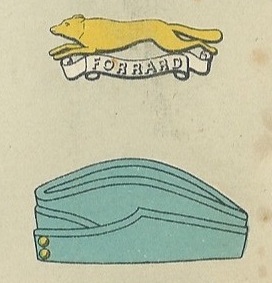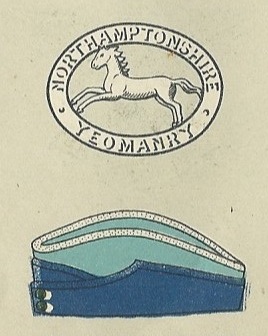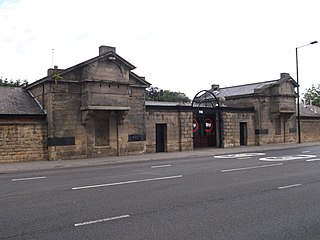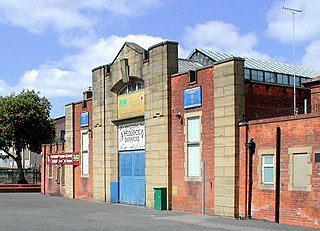Options for Change was a restructuring of the British Armed Forces in summer 1990 after the end of the Cold War.
The East and West Riding Regiment was a regiment of the British Territorial Army from 1999 to 2006. In 2006, it was re-designated as the 4th Battalion The Yorkshire Regiment.

104 Regiment Royal Artillery is part of the British Army Reserve and has sub-units throughout Wales and the West Midlands of England. It is equipped with the 105mm Light Gun.

The West Riding Artillery was formed as a group of volunteer units of the British Army in 1860. Its units later formed the divisional artillery of the West Riding Division of the Territorial Force in World War I and World War II. The West Riding Artillery's lineage is continued in a battery of today's Army Reserve
101 (Northumbrian) Medium Regiment Royal Artillery is part of the Army Reserve and has sub units throughout the north east as well as one sub unit in Leeds, West Yorkshire. It is equipped with M270 Multiple Launch Rocket System (MLRS).

The Northumberland Hussars was a Yeomanry regiment of the British Army, transferred to the Royal Artillery for the duration of the Second World War. It was disbanded as an independent Territorial Army unit in 1967, a time when the strength of the Territorial Army was greatly reduced. The regiment's name lives on in the title of the command and support squadron of the Queen's Own Yeomanry (QOY), a Formation Reconnaissance Regiment based in Newcastle upon Tyne.
In countries whose armies are organised on a regimental basis, such as the army of the United Kingdom, a regimental museum is a military museum dedicated to the history of a specific army regiment.

The South Nottinghamshire Hussars is a unit of the British Army formed as volunteer cavalry in 1794. Converted to artillery in 1922, it presently forms part of 103 Regiment, Royal Artillery.

The Duke of York's Own Loyal Suffolk Hussars was a Yeomanry regiment of the British Army. Originally formed as a volunteer cavalry force in 1793, it fought in the Second Boer war as part of the Imperial Yeomanry. In the World War I the regiment fought at Gallipoli, in Palestine and on the Western Front. The unit was subsequently converted into a Royal Artillery unit, serving in the anti-tank role North Africa, Italy and France during World War II. The lineage is maintained by No. 677 Squadron AAC.

The Queen's Own Yorkshire Dragoons was a yeomanry regiment of the British Army in existence from 1794 to 1956. It was formed as a volunteer cavalry force in 1794 during the French Revolutionary Wars. Its volunteer companies played an active role with the Imperial Yeomanry in the Second Boer War, but opportunities for mounted action were much more restricted during the First World War and it was temporarily converted into a cycle unit. It remained a cavalry regiment throughout the interwar years, and was the last horsed unit of the British Army to see action, in the Syria–Lebanon Campaign of 1941, finally mechanising the following year. It served as motorised infantry in the North African and Italian campaigns of the Second World War. In 1956, it merged with the Yorkshire Hussars and the East Riding of Yorkshire Yeomanry to form the Queen's Own Yorkshire Yeomanry. Its lineage is continued today by A Squadron, the Queen's Own Yeomanry.

The East Riding of Yorkshire Yeomanry was a unit of the British Army formed in 1902. Units of Yeomanry Cavalry were raised in the East Riding of Yorkshire in the 18th and early 19th centuries at times of national emergency: the Jacobite Rising of 1745, the French Revolutionary Wars and the Napoleonic Wars. These were stood down once each emergency was over. The East Riding of Yorkshire Yeomanry, was established in 1902, and this saw action during the First World War both in the mounted role and as machine gunners.

The Northamptonshire Yeomanry was a Yeomanry regiment of the British Army, formed in 1794 as volunteer cavalry. It served in the Second Boer War, the First World War and the Second World War before being reduced to squadron level in 1956. It ceased to have a separate existence in 1971.
In September 1939, the British Army was in process of expanding their anti-aircraft and mobile assets. Among these new changes was the formation of Anti-Aircraft Command which was formed on 1 April 1939, and the 1st Armoured Division formed in 1937. The list below will include the British Army units, colonial units, and those units which were in the process of formation.

Fenham Barracks is a military installation in Barrack Road, Newcastle upon Tyne, Tyne and Wear, England.

Londesborough Barracks is a military installation in Kingston upon Hull, England.

The West Riding Heavy Battery, Royal Garrison Artillery was a part-time unit of Britain's Territorial Force formed in 1908 in the West Riding of Yorkshire. It fought on the Western Front during World War I, and served on in the Territorial Army until the eve of World War II.

The King's Road drill hall, sometimes referred to as the Old Cavalry Barracks, is a former military installation in King's Road in Bury St Edmunds. It is a Grade II listed building.

Wenlock Barracks is a military installation on Anlaby Road in Kingston upon Hull, England.














